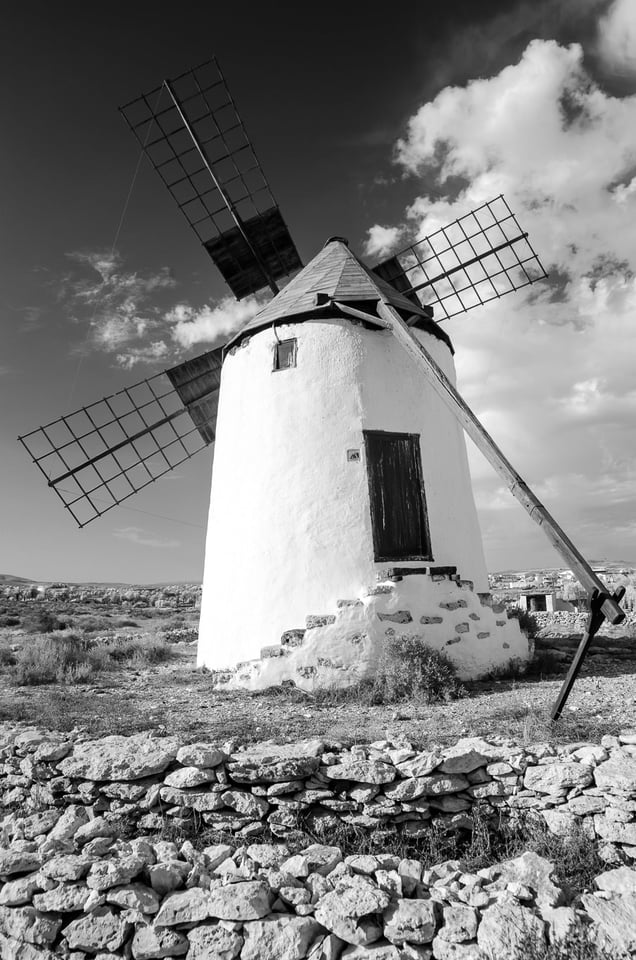In this third part of the series Photographing Canary Islands, we will have a look at Fuerteventura, or the island of endless golden beaches. An island that is very dry and due to its proximity to Africa also very warm. The landmark of Fuerteventura is not only the beaches but also the famous windmills. Apart from that, you can also photograph mountains and lighthouses, sand dunes and other subjects. Here are my four tips based on my personal experience.
Windmills (Molinos de Viento)
The old wind mills are very picturesque. There is roughly a dozen of them in Fuerteventura, more than on any other Canary Islands. These windmills are attractive. Some are nicely renovated, some are worn-out and half-broken. I find the windmills to very photogenic regardless of their state of repair. In Spanish, there are two terms distinguishing two sorts of windmills: male (Molino) and female (Molina) windmills. A Molino is two-storey and has a pitched roof. A Molina is only one-storey and has a flat roof.

The most famous windmill is Molino de Tefia. Tefia is a small village in northeastern Fuerteventura, located on the FV-207 half way to La Olivia. On the southern edge of Tefia, between the local roads FV-221 and the FV-207, you will find the Molino de Tefia. It is an old and beautifully restored windmill – unfortunately, the windmill paddle have been damages lately (I guess due to some gale wind).

This windmill is located next to the Observatory Astronómico de Fuerteventura. This is a good place to take night composition with milky way, especially in late summer as the southwestern horizon is not plagued by much light pollution. During my stay, the Calima haze (dust coming from Sahara desert) did not allow me to shoot stars above the windmill. A nice time to take photos (especially if you want to get silhouettes) is just before sunset.
My favorite windmills are located in Vallaverde (hence the name Molinos de Villaverde). There two of them and they are built on small hillock. This enables composition that are not possible at other places with single moline located on a flat ground.


Relatively less known, but very picturesque windmill Molino de el Roque is located between the town of El Cotillo and the El Roque village. This windmill is surrounded by palm trees. I found the location to be very good for night photos. The windmill was nicely lit by the surrounding villages, but the southern horizon was clear of any pollution.

Faro de Toston
There are quite few lighthouses scattered around the coastal line of Canary Islands. Not all of them easy to access, moreover not all of them are visually attractive. I found the Fare de Toston (Toston Lighthouse) near the small town Cotillo to be a very good location for photographers. You can walk around the windmill and get close as well as more distant compositions, giving you plentiful motifs for different foregrounds. I photographed here during sunset, but sunrise would be good as well.


Coralejo Sand Dunes
At the very northern tip of Fuerteventura, you can find the Parque Natural de las Dunas de Corralejo. It boasts the largest sand dunes of the Canary Islands. With miles of near-white sand beaches, clear turquoise waters, huge dunes and a contrasting red and black volcanic landscape, it is a great location for any photographer.


Even if I saw some amazing photos of huge sand dunes when researching the location before I went there, I could find only smaller dunes. I used the main road as one of the motifs as well as some plants. My guess is that if you want to find big dunes and no distracting objects (people, road, parked cars) around, you would have to walk quite deep into the desert. So be prepared for that. I would recommend scouting the location before going there for the final shooting in golden hour.


The golden beaches along this natural park also stunning.
Montana de Tindaya
Tindaya mountain is located in the northeast of Fuerteventura, near the town of La Oliva. The ancient inhabitants of the island considered the mountain sacred and attributed some magical qualities to it. More than three hundred archaeological engravings in the shape of a footprint can be found here.


The mountain is 400 meters and rises quite majestically above the rather flat arid countryside, typical of the island of Fuerteventura. I had a bad luck for weather, but combined with some good light, you can take some very interesting compositions around this place.

El Cotillo
In this little town, you can find a few nice beaches and also an old fortress. Nothing spectacular, but since the other recommended places are nearby (Molino de el Roque and Faro de Toston), it is worthwhile visiting.




Other Places I Could not Visit
If I had more time and luck for better weather (during my stay, it was extremely hazy, even foggy) I would explore the southern part of Fuerteventura. Cofete region is quite famous for the combination of pristine beaches and volcanic mountains in the background.

As for the rest of the island: if you want to see more beaches, I have seen some very interesting photos of Playa Esquinzo and Playa de Sotavento.
If you cannot visit Lanzarote, Tenerife or La Palma, It might be interesting to climb the caldera of old extinct volcano Hondo (between Lajares and Corralejo) to experience the volcanic landscape.
Table of Contents